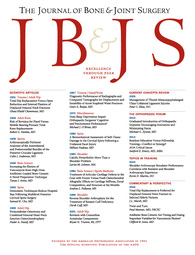
SHOULDER & ELBOW
Effects of physiotherapy, acromioplasty, and repair for nontraumatic rotator cuff tear
This report has been verified
by one or more authors of the
original publication.
J Bone Joint Surg Am. 2015 Nov 4;97(21):1729-37.
180 shoulders of patients with a non-traumatic, isolated, full-thickness supraspinatus tear were randomized to receive physiotherapy either alone, with acromioplasty, or with both acromioplasty and surgical repair of the tear. The purpose of the study was to compare the efficacy of treatments in terms of clinical outcome, radiographic outcome, and cost. No significant differences between groups in Constant shoulder score for function, VAS pain, or patient satisfaction were noted between groups at 2 year follow-up. Patients who had undergone surgical repair had significantly smaller rotator cuff tears on MRI at 2 year follow-up compared to the other groups. No significant difference was observed in Constant score between those with full-thickness tear and those with a healed tear at 2 years. Costs were significantly different between groups, being lowest in the physiotherapy group and highest in the group receiving all 3 treatments.
Unlock the full ACE Report
You have access to {0} free articles per month.Click below to unlock and view this {1}
Unlock NowCritical appraisals of the latest, high-impact randomized controlled trials and systematic reviews in orthopaedics
Access to OrthoEvidence podcast content, including collaborations with the Journal of Bone and Joint Surgery, interviews with internationally recognized surgeons, and roundtable discussions on orthopaedic news and topics
Subscription to The Pulse, a twice-weekly evidence-based newsletter designed to help you make better clinical decisions
Exclusive access to original content articles, including in-house systematic reviews, and articles on health research methods and hot orthopaedic topics
Or upgrade today and gain access to all OrthoEvidence content for just $1.99 per week.
Already have an account? Log in


Subscribe to "The Pulse"
Evidence-Based Orthopaedics direct to your inbox.
{0} of {1} free articles
Become an OrthoEvidence Premium Member. Expand your perspective with high-quality evidence.
Upgrade Now













































































